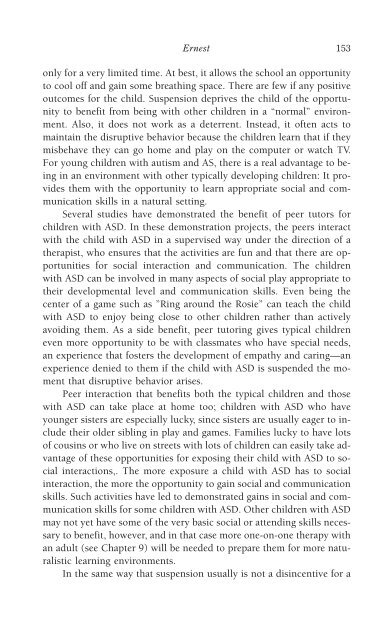978-1572305441
autism
autism
You also want an ePaper? Increase the reach of your titles
YUMPU automatically turns print PDFs into web optimized ePapers that Google loves.
Ernest 153<br />
only for a very limited time. At best, it allows the school an opportunity<br />
to cool off and gain some breathing space. There are few if any positive<br />
outcomes for the child. Suspension deprives the child of the opportunity<br />
to benefit from being with other children in a “normal” environment.<br />
Also, it does not work as a deterrent. Instead, it often acts to<br />
maintain the disruptive behavior because the children learn that if they<br />
misbehave they can go home and play on the computer or watch TV.<br />
For young children with autism and AS, there is a real advantage to being<br />
in an environment with other typically developing children: It provides<br />
them with the opportunity to learn appropriate social and communication<br />
skills in a natural setting.<br />
Several studies have demonstrated the benefit of peer tutors for<br />
children with ASD. In these demonstration projects, the peers interact<br />
with the child with ASD in a supervised way under the direction of a<br />
therapist, who ensures that the activities are fun and that there are opportunities<br />
for social interaction and communication. The children<br />
with ASD can be involved in many aspects of social play appropriate to<br />
their developmental level and communication skills. Even being the<br />
center of a game such as ”Ring around the Rosie” can teach the child<br />
with ASD to enjoy being close to other children rather than actively<br />
avoiding them. As a side benefit, peer tutoring gives typical children<br />
even more opportunity to be with classmates who have special needs,<br />
an experience that fosters the development of empathy and caring—an<br />
experience denied to them if the child with ASD is suspended the moment<br />
that disruptive behavior arises.<br />
Peer interaction that benefits both the typical children and those<br />
with ASD can take place at home too; children with ASD who have<br />
younger sisters are especially lucky, since sisters are usually eager to include<br />
their older sibling in play and games. Families lucky to have lots<br />
of cousins or who live on streets with lots of children can easily take advantage<br />
of these opportunities for exposing their child with ASD to social<br />
interactions,. The more exposure a child with ASD has to social<br />
interaction, the more the opportunity to gain social and communication<br />
skills. Such activities have led to demonstrated gains in social and communication<br />
skills for some children with ASD. Other children with ASD<br />
may not yet have some of the very basic social or attending skills necessary<br />
to benefit, however, and in that case more one-on-one therapy with<br />
an adult (see Chapter 9) will be needed to prepare them for more naturalistic<br />
learning environments.<br />
In the same way that suspension usually is not a disincentive for a



